(NewsNation) — NASA’s James Webb Space Telescope has captured images of 19 spiral galaxies showing “staggering” structure.
The photos released Monday by NASA depict galaxies with “clearly defined arms” brimming with stars, as well as centers comprising old star clusters or supermassive black holes.
The images are part of the Physics at High Angular resolution in Nearby GalaxieS (PHANGS) program, NASA said in a news release.
“Webb’s new images are extraordinary,” Janice Lee, a project scientist for strategic initiatives at the Space Telescope Science Institute in Baltimore, said in the news release. “They’re mind-blowing even for researchers who have studied these same galaxies for decades. Bubbles and filaments are resolved down to the smallest scales ever observed, and tell a story about the star formation cycle.”
Millions of stars were captured in the images, which appear in blue tones. Some are spread throughout the galaxies’ spiral arms, while others are in clusters.
Also seen are stars not yet fully formed that are encased in gas and dust that feed their growth.
“These are where we can find the newest, most massive stars in the galaxies,” Erik Rosolowsky, a professor of physics at the University of Alberta in Edmonton, Canada, said in the news release.
The center of the galaxies tell a story, too. Areas near the core that look blue are populations of older stars, while pink and red “refraction spikes” possibly indicate a supermassive black hole.
“Or, the star clusters toward the center are so bright that they have saturated that area of the image,” said Eva Schinnerer, a staff scientist at the Max Planck Institute for Astronomy in Heidelberg, Germany.
The Webb photos provide a new look at some of the galaxies that were previously photographed by the Hubble Space Telescope.
“The amount of analysis that can be done with these images is vastly larger than anything our team could possibly handle,” Rosolowsky said. “We’re excited to support the community so all researchers can contribute.”
See a gallery of the images below.
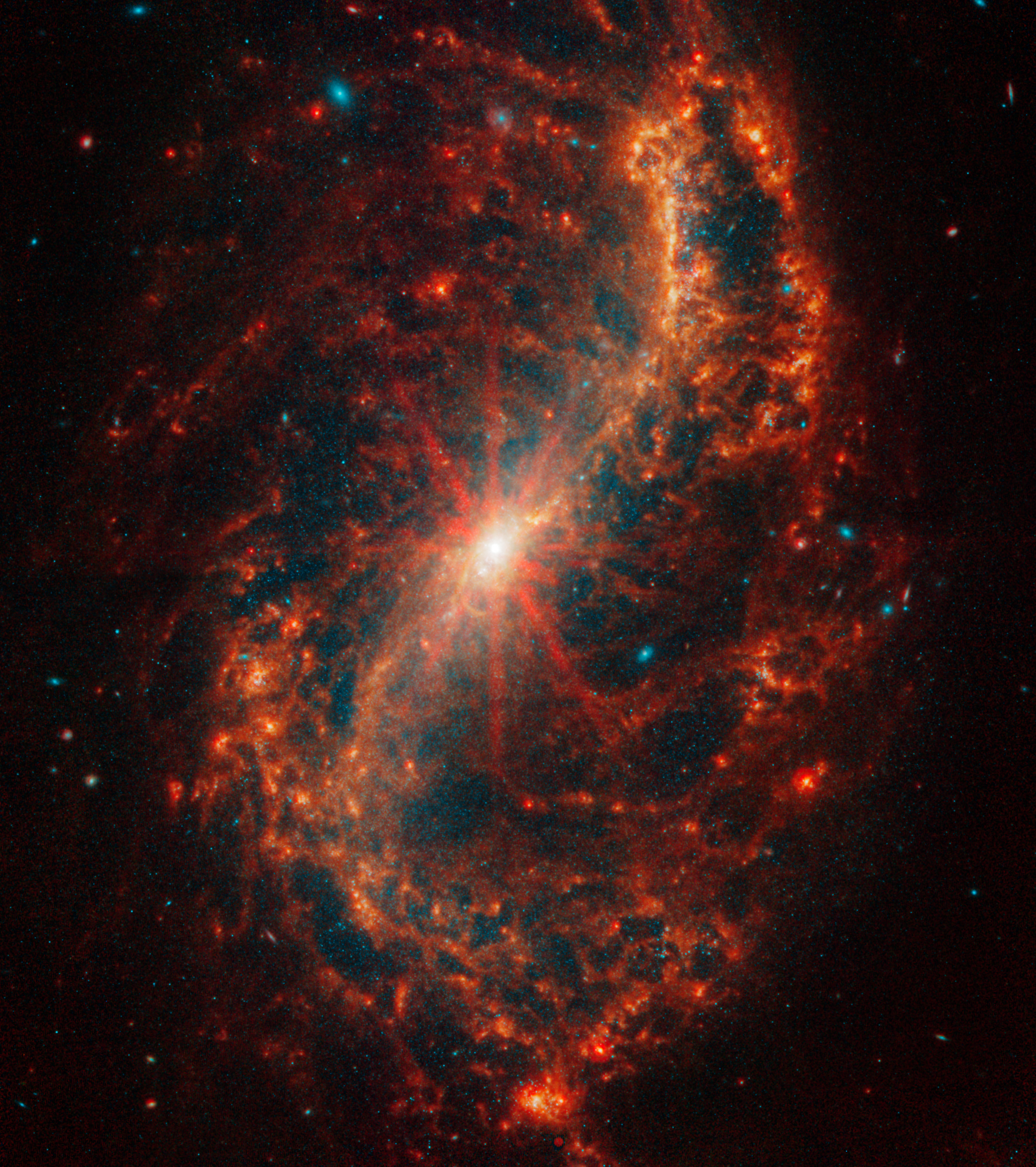
The central core of Webb’s image of NGC 7496 is very small compared to the rest of the galaxy. This central region starts as a bright white dot that melts into bright oranges. Eight prominent diffraction spikes emanate from the center, taking up about one sixth of the image. A bright orange arc that looks like a thin, backward S forms a bar and two of the face-on spiral galaxy’s arms. The majority of the image shows shades of orange and red, forming irregular, diffuse spiral shapes that flow counterclockwise. The corners and a few gaps among the spiral arms are largely black, and where larger or smaller bright blue dots appear. Several prominent, larger red, red-and-white, and red-and-blue dots appear toward the edges. (NASA, ESA, CSA, STScI, Janice Lee (STScI), Thomas Williams (Oxford), PHANGS Team) 
Webb’s image of NGC 5068 shows a portion of a messy face-on barred spiral galaxy in shades of white, yellow, orange, and red. The galaxy’s bar is a yellow arc-shaped region toward the center-left. It is very difficult to see a spiral shape. Scattered across the scene are some bright blue pinpoints of light, but they appear more clearly in areas where it is dark gray or black. This includes the area to the right of the yellow central arc, near the galaxy’s bar. There are many bright red and orange regions. The left side and the top right corner have more irregular orange shapes, but the area between them is significantly darker, with only a few lighter red areas that look like smoke drifting up. (NASA, ESA, CSA, STScI, Janice Lee (STScI), Thomas Williams (Oxford), PHANGS Team) 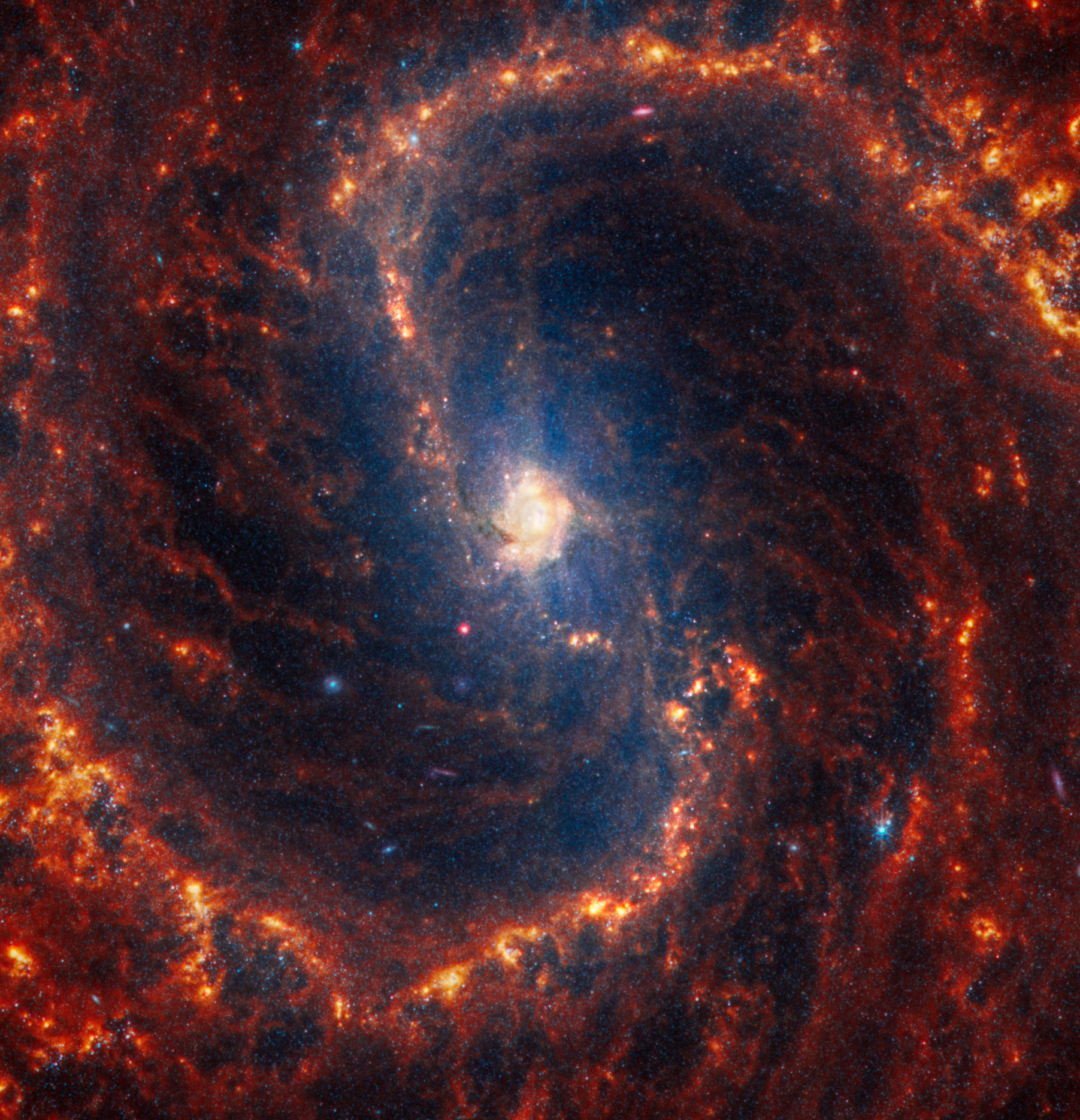
Webb’s image of NGC 4535 shows a densely populated face-on barred spiral galaxy anchored by its small central region, which has a light orange haze. Toward the center, the bar structure is filled with a blue haze of stars that forms a roughly vertical oval shape that stretches across most of the frame. Filaments of glowing dust cross the bar and are connected to two prominent spiral arms made of stars, gas, and dust. These structures start at the center, creating line-like arcs that go from the top and curve around to the right, and from the bottom right in an arc that curves up to the top left, forming an elongated S shape. The spiral arms rotate clockwise and are largely orange, ranging from dark to bright orange, brightest at the edges. Scattered across the packed scene are some additional bright blue pinpoints of light, which are stars and star clusters spread throughout the galaxy. In the darker areas, it’s easier to spot brighter larger pinpoints of light. Some of these are blue and some are pink. A few appear more like ovals at the edges. (NASA, ESA, CSA, STScI, Janice Lee (STScI), Thomas Williams (Oxford), PHANGS Team) 
Webb’s image of NGC 4321 shows a face-on spiral galaxy anchored by its central region, which is located at far right, midway down, slightly cut off at far right. It is shaped like a smashed circle, with a bright white point at the center, a blue circle around that, ending in a bright, thick yellow-and-orange outer ring. A light blue haze of stars surrounds the bright yellow central area. Darker, more diffuse orange arms spiral away counterclockwise. A number of filamentary orange spiral arms made of stars, gas, and dust appear in the majority of the frame, but the spirals appear more like irregular, clumpy arcs since the observation does not show the full galaxy. One prominent spiral arm arcs across the bottom of the frame. The spiral arms are largely orange, ranging from dark to bright. Within the orange spiral arms, there are small irregular oval areas that appear darker or black, where it’s easier to see blue stars or clusters of tiny blue stars. (NASA, ESA, CSA, STScI, Janice Lee (STScI), Thomas Williams (Oxford), PHANGS Team) 
Webb’s image of NGC 4303 shows a portion of the face-on barred spiral galaxy anchored by its central region, which is located at far right, midway down. It is shaped like a circle, with a bright white point at the center, a blue circle around that, ending in a bright, thick yellow outer ring. A bar structure filled with a light blue haze surrounds the bright yellow central area. Darker orange arms spiral away counterclockwise. A number of filamentary orange spiral arms made of stars, gas, and dust appear in the majority of the frame, but the spirals appear more like arcs since the observation does not show the full galaxy. The spiral arms are largely orange, ranging from dark to bright. Within the orange spiral arms, there are small irregular oval areas that appear darker or black, where it’s easier to see clusters of tiny blue stars. Smaller triangular areas at bottom left and top left appear darkest black. (NASA, ESA, CSA, STScI, Janice Lee (STScI), Thomas Williams (Oxford), PHANGS Team) 
Webb’s image of NGC 4254 shows a densely populated face-on spiral galaxy anchored by its central region, which has a light blue haze, with a tiny blue dot at its core. This central region appears to the right of center. Spiny spiral arms made of stars, gas, and dust start at the center, rotating counterclockwise. The spiral arms extend off the frame in all directions. The spiral arm to the right is more distinct than the ones found to the left. The spiral arms of the galaxy are largely orange, ranging from dark to bright orange. Scattered across the packed scene are some additional bright blue pinpoints of light, which are stars or star clusters spread throughout the galaxy. In areas where there is less orange, it is darker, and some dark regions look more circular. (NASA, ESA, CSA, STScI, Janice Lee (STScI), Thomas Williams (Oxford), PHANGS Team) 
Webb’s image of NGC 3627 shows a face-on barred spiral galaxy anchored by its central region, which has a bright blue central dot surrounded by a lighter diagonal blue bar structure made of a haze of stars, which forms an angled oval toward the top. The central core and bar fill about a third of the image. Two distinct spiny spiral arms made of stars, gas, and dust also start at the center, appearing brown or greenish within the blue bar, and extending to the edges, rotating counterclockwise in bright oranges. The brightest areas of the arms are two large arcs that start at the central region. The one at left stretches up to the top in a long arc and another at right extends toward the bottom. Scattered across the packed scene are bright blue pinpoints of light, which are stars spread throughout the galaxy. In areas where there is less orange, it is darker. A triangular area at bottom right is largely the black background of space. (NASA, ESA, CSA, STScI, Janice Lee (STScI), Thomas Williams (Oxford), PHANGS Team) 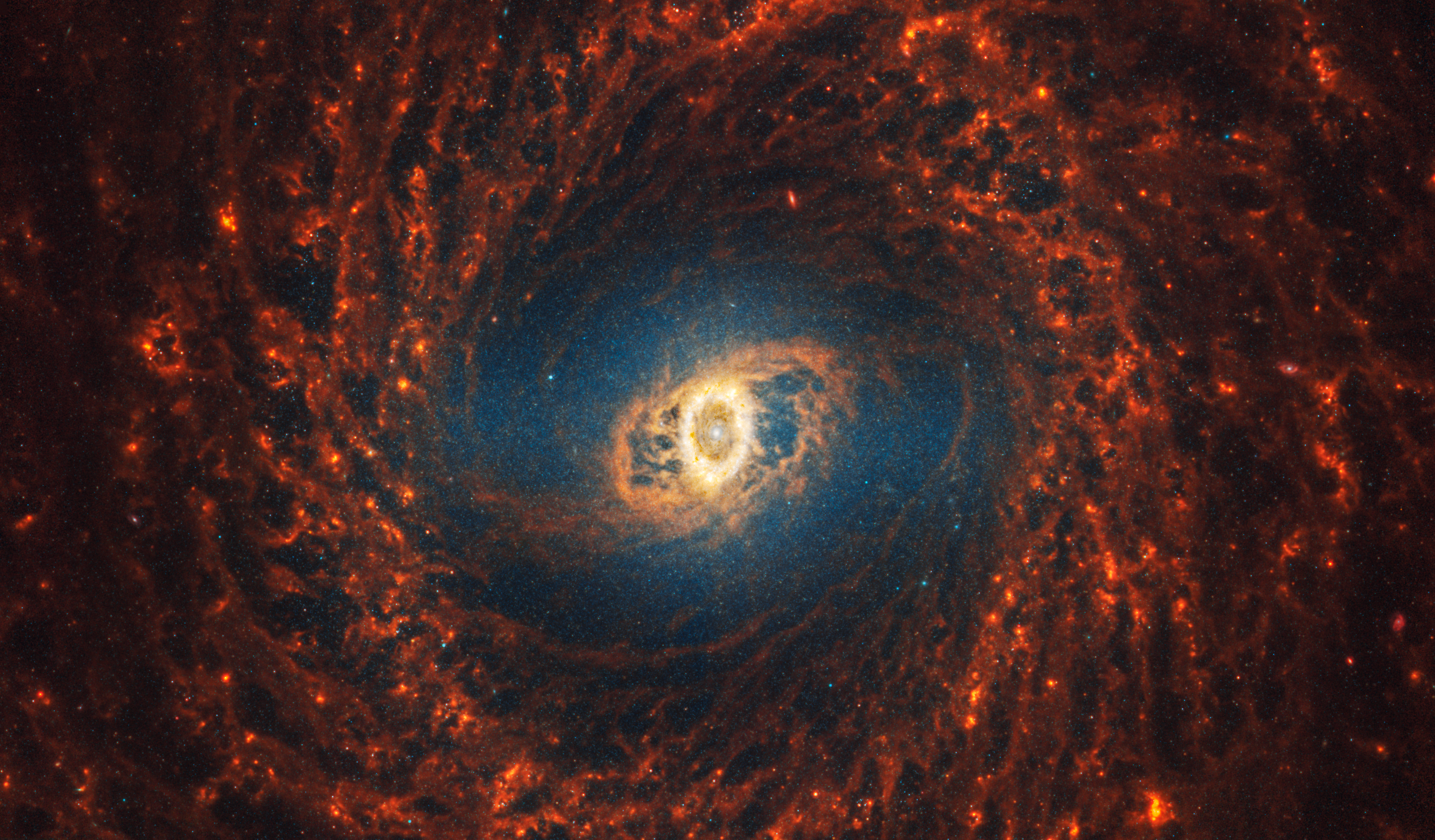
Webb’s image of NGC 3351 shows a face-on barred spiral galaxy anchored by its central region, which is oval and shows a bright white point at the center with darker and lighter yellow ovals around it. Around those are a horizontal oval of lighter orange. The galaxy’s roughly horizontal bar structure appears as a light blue haze of stars that covers about a third of the image. Darker, more diffuse orange dust lanes cross the bar from bottom left to top right. A number of filamentary orange spiral arms made of stars, gas, and dust connect to the bar and consume the rest of the area. The spiral arms are largely orange, ranging from dark to bright orange and extend beyond the edges of the image. They form a roughly circular shape, making it appear as if there’s movement in a still image. Within the orange spiral arms, there are small oval areas that appear black, where it’s easier to see tiny blue stars. (NASA, ESA, CSA, STScI, Janice Lee (STScI), Thomas Williams (Oxford), PHANGS Team) 
Webb’s image of NGC 2835 shows a densely populated face-on spiral galaxy anchored by its small central region, which is immediately engulfed in the orange spiral arms. A blue glow of stars begins at the core and spreads outward. Spiny orange spiral arms made of stars, gas, and dust start at the center and extend to the edges, rotating counterclockwise and taking up most of the area. Tiny pinpoints of blue light, which are stars or star clusters, are scattered across the image, but are easiest to spot where there appear to be black bubbles within the orange dust. The spiral arms of the galaxy are largely orange, ranging from dark to bright orange. In a few areas, there are bright orange patches of light within the orange spiral arms, mainly toward the outer edges of the spiral arms. Toward the bottom are some larger pink and blue points of light, some are likely background galaxies that appear like disks seen from the side. (NASA, ESA, CSA, STScI, Janice Lee (STScI), Thomas Williams (Oxford), PHANGS Team) 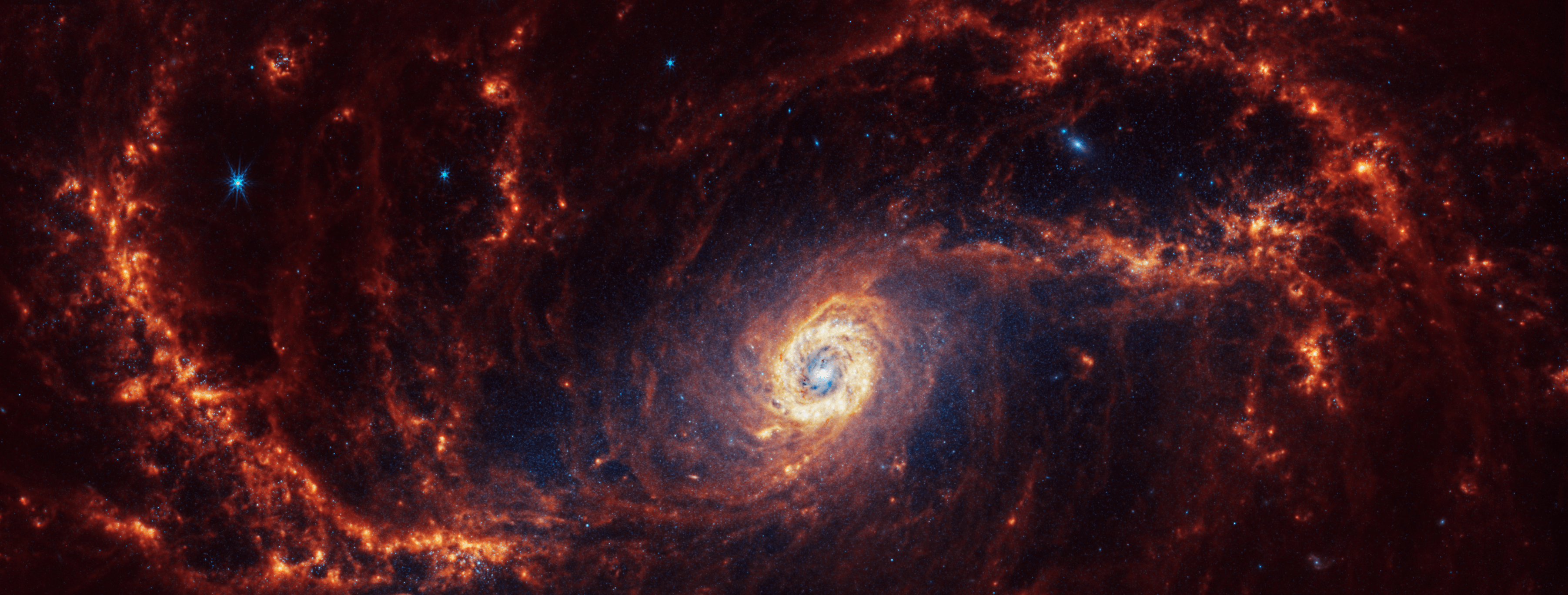
Webb’s image of the galaxy NGC 1672 shows a portion of a face-on barred spiral galaxy anchored by its central region, which is circular and has a bright white point at the center with blue and then yellow circular regions around it, anchored to the right of center. A roughly horizontal bar structure made of a blue haze of stars and filamentary orange dust lanes tilts up slightly and takes up the majority of the image. Two spiny orange spiral arms made of stars, gas, and dust connect to the end of the bar and extend outward, rotating clockwise. The spiral arms are largely orange, ranging from dark to bright orange and extend beyond the edges of the image. They are brightest orange away from the bright central region at left and right, like knots of orange beads strung together. The spiral shape of the galaxy is less apparent in this view, with the arms looking more like irregular waves in an ocean’s tides. There are many more dark or black regions between where the orange gas and dust of the bar and spiral arms appear. Scattered across the scene are some bright blue pinpoints of light. (NASA, ESA, CSA, STScI, Janice Lee (STScI), Thomas Williams (Oxford), PHANGS Team) 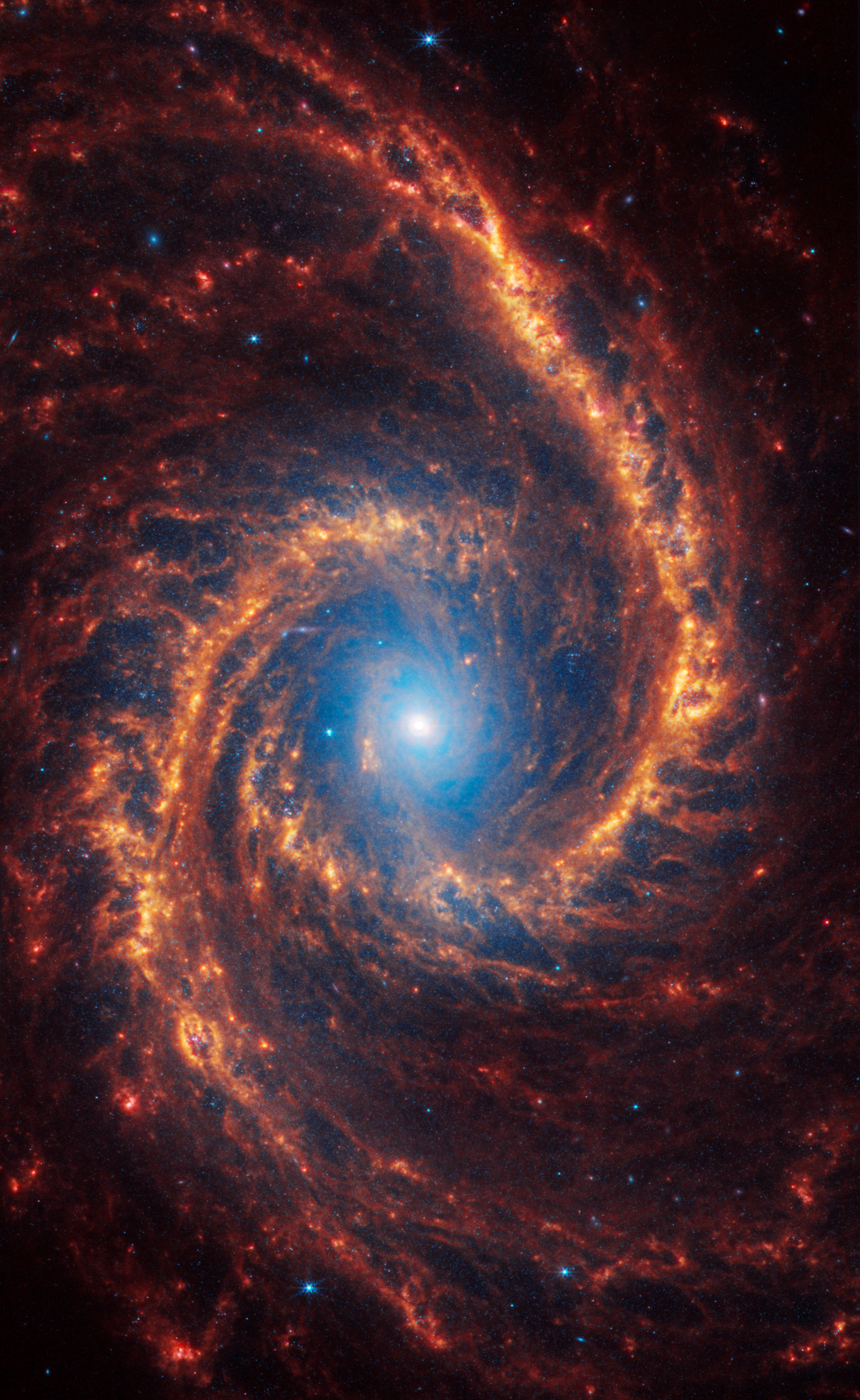
Webb’s image of the galaxy NGC 1566 shows a densely populated face-on spiral galaxy anchored by its slightly oval central region, consisting of a core and small bar structure, which has a light blue haze of stars that covers about a quarter of the view. Two prominent spiny spiral arms made of stars, gas, and dust also start at the center, within the blue haze, and extend to the edges, rotating counterclockwise. The spiral arms of the galaxy are largely orange, ranging from dark to bright orange. The brightest areas of the arms are two large arcs that start at the central region and stretch up to the top and bottom. Scattered across the packed scene are innumerable bright blue pinpoints of light, which are stars spread throughout the galaxy. In areas where there is less orange, it is darker, and some dark regions look more circular. There are bright pink patches of light toward the outer regions of the spiral arms. (NASA, ESA, CSA, STScI, Janice Lee (STScI), Thomas Williams (Oxford), PHANGS Team) 
Webb’s image of NGC 1512 shows a face-on barred spiral galaxy anchored by its central region, which is circular and shows a bright white point at the center with blue and yellow circles around it. Outside the core is a large bar structure filled with a haze of blue stars, forming a rough parallelogram shape and taking up about a quarter of the area. The bar is crossed by orange filaments made of stars, gas, and dust that extend diagonally to the top left and bottom right. Outside this, the thick orange spiral arms form a rough oval, and within them there are smaller oval areas that appear black. The spiral arms are largely orange, ranging from dark to bright orange and extend beyond the edges of the image. There are many larger blue stars and slightly larger pink points of light spread throughout. Two larger foreground stars with at least six diffraction spikes are at top center and bottom center. (NASA, ESA, CSA, STScI, Janice Lee (STScI), Thomas Williams (Oxford), PHANGS Team) 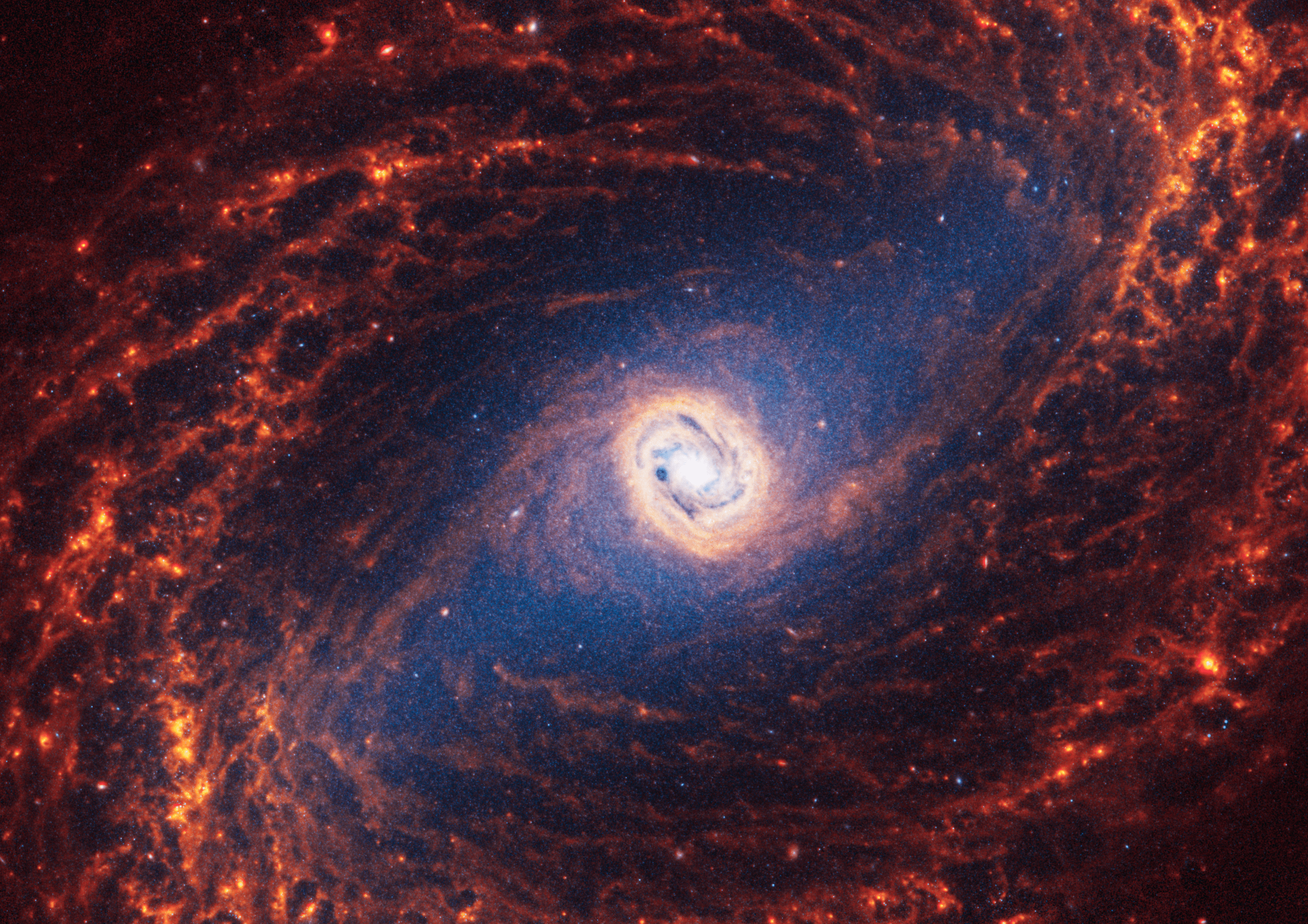
Webb’s image of NGC 1433 shows a face-on barred spiral galaxy anchored by its central region, which is circular and shows a bright white point at the center with a yellow circle around it. The central core covers about a fifth of the total image. Extending from the core is a large bar structure made of a blue haze of stars, forming a rough parallelogram and taking up about a quarter of the area. Filamentary orange dust lanes cross the bar, extend diagonally to the top and bottom, and connect to the spiral arms made of stars, gas, and dust. The spiral arms rotate counterclockwise and are largely orange, ranging from dark to bright orange and extend beyond the edges of the image. Scattered across the scene are very few bright blue pinpoints of light. Outside this, but within the orange spiral arms are smaller oval areas that appear black. There are many larger blue stars and slightly larger pink points of light spread throughout the overall image. (NASA, ESA, CSA, STScI, Janice Lee (STScI), Thomas Williams (Oxford), PHANGS Team) 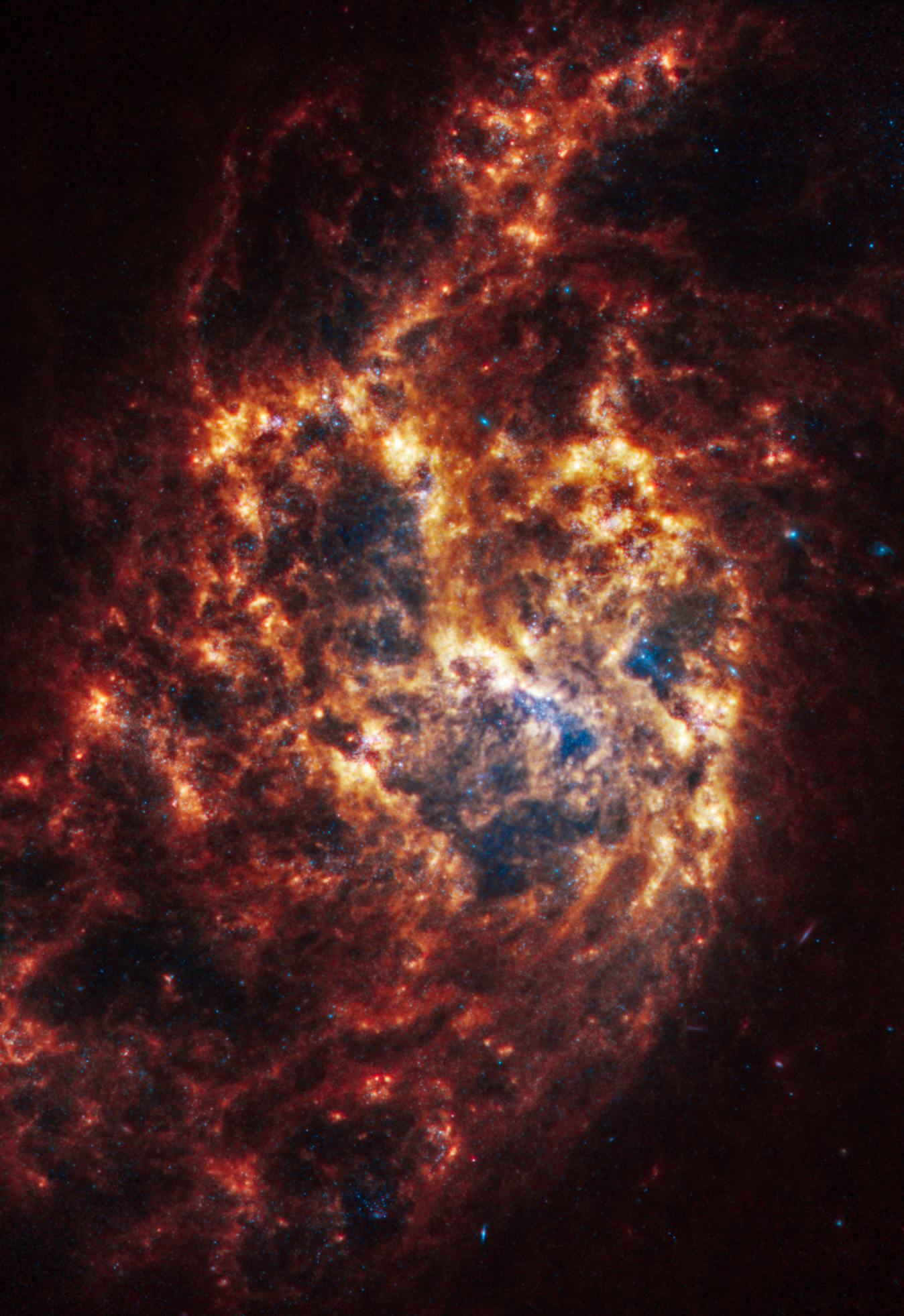
Webb’s image of NGC 1385 shows a messy face-on spiral galaxy in shades of white, yellow, orange, and red. There’s a bright yellow arc-shaped region toward the center, but it is very difficult to see a spiral shape. Scattered across the scene are some bright blue pinpoints of light, but they appear more clearly in areas where it is dark gray or black, below and to the right of the yellow central arc in blobs, with some individual blue points of light across the image. There are many bright red or orange regions in the orange arms, speckled irregularly throughout. The edges of the scene are dark black, containing several very faint pink, blue, and red blobs. (NASA, ESA, CSA, STScI, Janice Lee (STScI), Thomas Williams (Oxford), PHANGS Team) 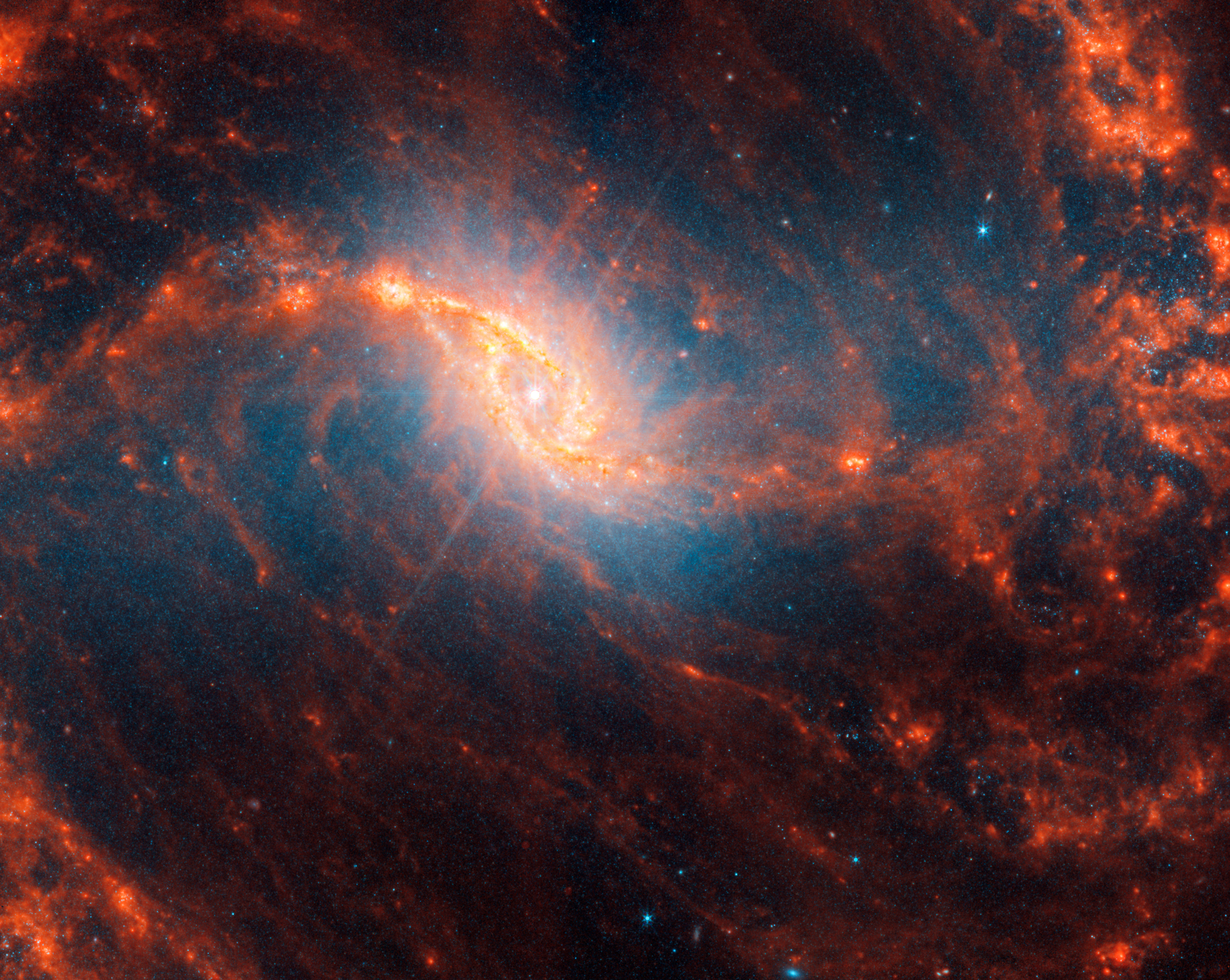
The core of Webb’s image of the barred spiral galaxy NGC 1365 appears slightly above center. It covers about an eighth of the total area of the image. This central region looks like an angled, smashed oval, with a bright white point at the center, which has at least six light white diffraction spikes that extend into the galaxy. The outer areas of the smashed oval are bright white, yellow, and orange, and extend at left and right into the galaxy’s bar. The bar structure continues horizontally, filling most of the frame. The galaxy’s outer core and bar are filled with a blue haze of stars. The bar is crossed by filamentary orange dust lanes that have a slight curve, forming a backward S shape. This is a crop of the full galaxy. The spiral arms begin at the very edge of the frame and appear to continue in bright red at all four edges. There are more diffuse, lighter red regions that look like curved jellyfish tentacles reaching from the galaxy’s bar to the bottom of the frame. The spiral arms rotate counterclockwise. Scattered in gaps between the spiral arms closest to the galaxy’s core are bright blue pinpoints of light. There are some slightly larger dots that are bright blue scattered across the image. A slightly larger blue star with eight diffraction spikes appears toward the top right. (NASA, ESA, CSA, STScI, Janice Lee (STScI), Thomas Williams (Oxford), PHANGS Team) 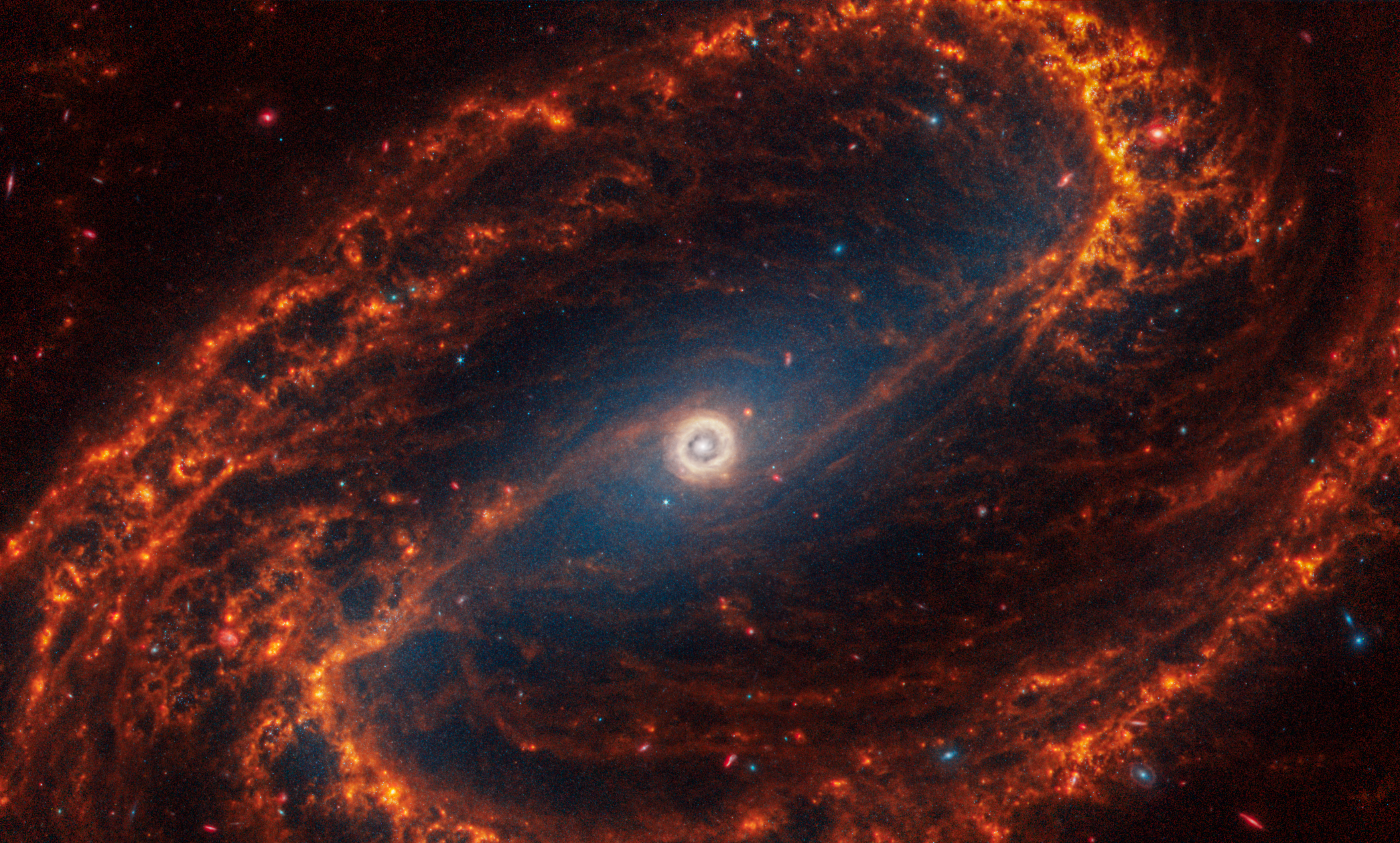
Webb’s image of NGC 1300 shows a face-on barred spiral galaxy anchored by its central region, which is circular and shows a bright white point at the center with a light yellow circle around it. The central core is tiny compared to the rest of the galaxy. The core extends into the galaxy’s prominent diagonal bar structure, which is filled with a blue haze of stars. Orange dust filaments cross the bar, extending diagonally to the top and bottom, connecting the yellow circle in the central core to the galaxy’s spiral arms. There are two distinct orange spiral arms made of stars, gas, and dust that start at the edges of the bar and rotate counterclockwise. Together, the arm and bars form a backward S shape. The spiral arms are largely orange, ranging from dark to bright orange. Scattered across the packed scene are very few bright blue pinpoints of light. There are vast areas between where the orange spiral arms wrap that appear black. The top left and bottom right edges are dark black and there are some larger red and blue points of light, some that appear like disks seen from the side. (NASA, ESA, CSA, STScI, Janice Lee (STScI), Thomas Williams (Oxford), PHANGS Team) 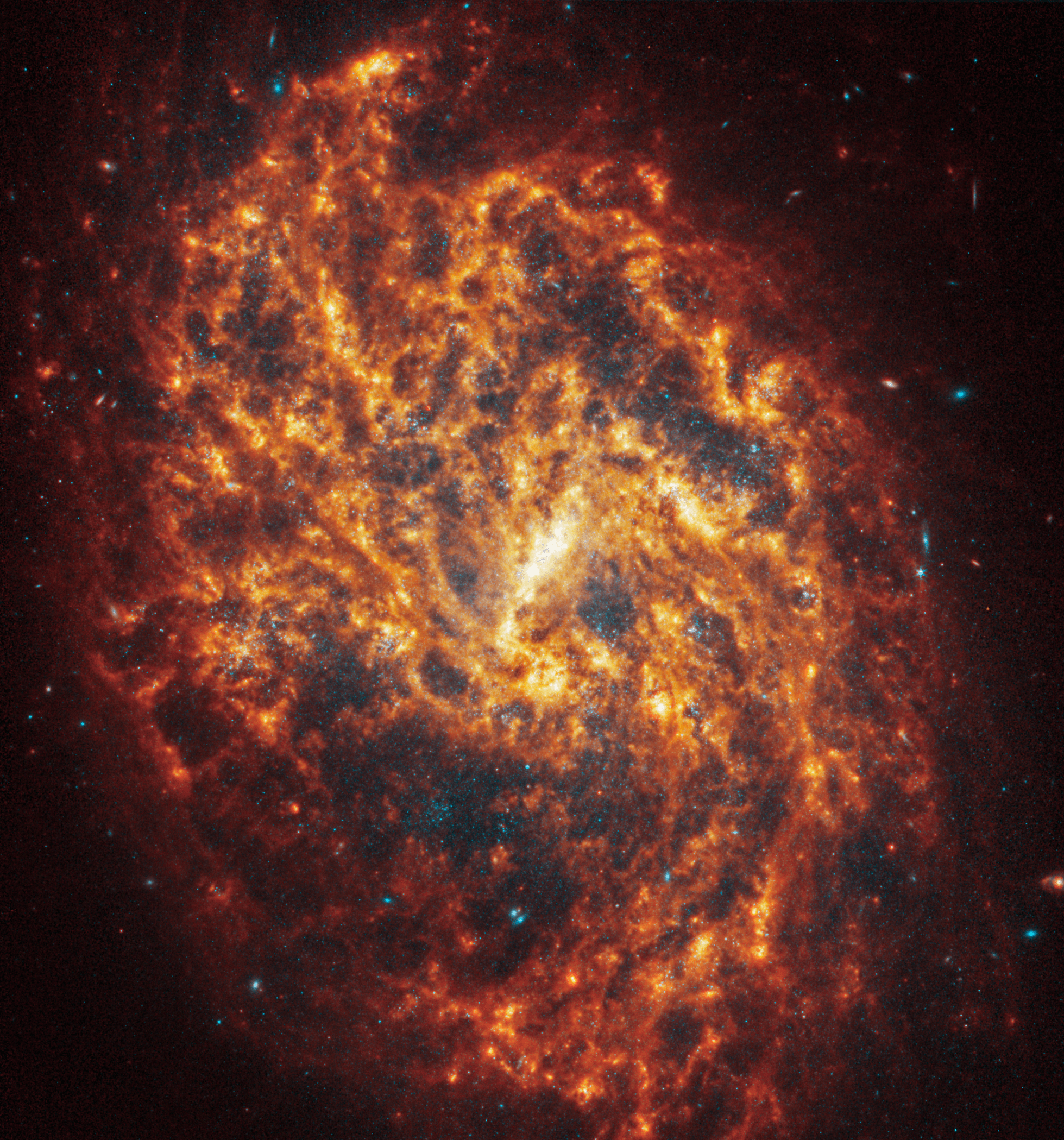
Webb’s image of NGC 1087 shows a densely populated face-on spiral galaxy anchored by its central region, which takes the shape of a short light yellow line that is about a fifth of the length of the galaxy. Filamentary spiral arms made of stars, gas, and dust start at the center and extend to the top and bottom edges, rotating clockwise. There is so much light in this region that the spiral arms of the galaxy look muddled. They are largely orange, ranging from dark to bright orange. Scattered across the packed scene are some bright blue pinpoints of light, but they appear more clearly in areas where it is dark gray or black. Several smaller “bubbles” where it’s black appears throughout the galaxy. The edges of the scene are dark black and there are some larger bright blue points of light, along with a few pink shapes, likely background galaxies. (NASA, ESA, CSA, STScI, Janice Lee (STScI), Thomas Williams (Oxford), PHANGS Team) 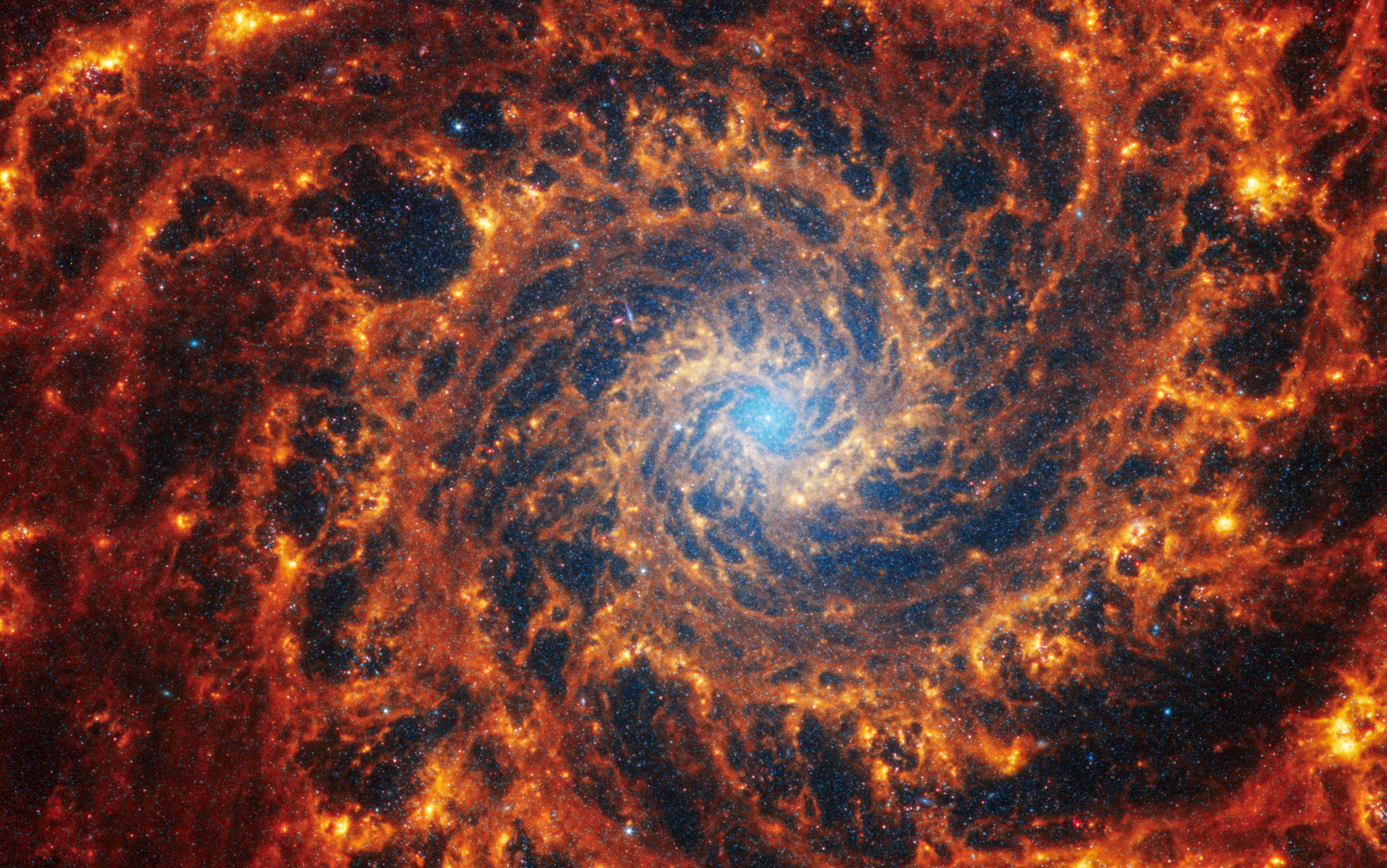
Webb’s image of NGC 628 shows a densely populated face-on spiral galaxy anchored by its central region, which has a light blue haze that takes up about a quarter of the view. In this circular core is the brightest blue area. Within the core are populations of older stars, represented by many pinpoints of blue light. Spiny spiral arms made of stars, gas, and dust also start at the center, largely starting in the wider area of the blue haze. The spiral arms extend to the edges, rotating counterclockwise. The spiraling filamentary structure looks somewhat like a cross section of a nautilus shell. The arms of the galaxy are largely orange, ranging from dark to bright orange. Scattered across the packed scene are some additional bright blue pinpoints of light, which are stars spread throughout the galaxy. In areas where there is less orange, it is darker, and some dark regions look more circular. A prominent dark “bubble” appears to the top left of the blue core. And a wider, elliptical “bubble” to the bottom right. (NASA, ESA, CSA, STScI, Janice Lee (STScI), Thomas Williams (Oxford), PHANGS Team) 
Webb’s image of IC 5332 shows a densely populated face-on spiral galaxy anchored by its central region, which has a light blue haze that takes up about a quarter of the view. Within the core are populations of older stars, represented by many pinpoints of blue light. Spine-like spiral arms made of stars, gas, and dust also start at the center, within the blue haze, and extend to the edges, rotating counterclockwise. The spiral arms of the galaxy range from dark to bright orange. Scattered across the packed scene are innumerable bright blue pinpoints of light, which are stars or star clusters spread throughout the galaxy. In areas where there is less orange, it is darker, and some dark regions look more circular. In a few areas, there are bright pink patches of light within the orange spiral arms. (NASA, ESA, CSA, STScI, Janice Lee (STScI), Thomas Williams (Oxford), PHANGS Team)






